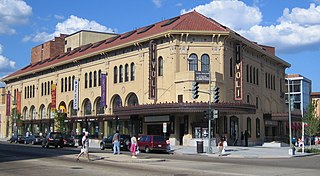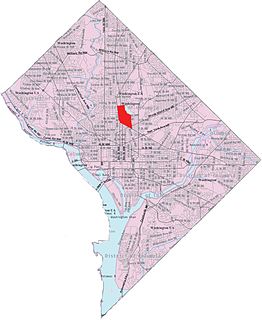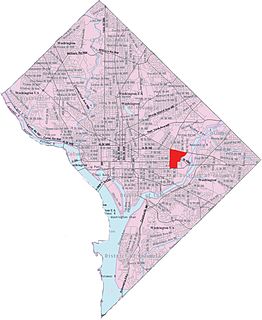Related Research Articles

Washington, D.C., formally the District of Columbia, also known as just Washington or simply D.C., is the capital city and federal district of the United States. It is located on the east bank of the Potomac River, which forms its southwestern and southern border with the U.S. state of Virginia, and it shares a land border with the U.S. state of Maryland on its remaining sides. The city was named for George Washington, a Founding Father and the first president of the United States, and the federal district is named after Columbia, a female personification of the nation. As the seat of the U.S. federal government and several international organizations, the city is an important world political capital. It is one of the most visited cities in the U.S., seeing over 20 million visitors in 2016.

The flag of Washington, D.C., consists of three red stars above two red bars on a white background. It is an armorial banner based on the design of the coat of arms granted to George Washington's great-great-great-grandfather, Lawrence Washington of Sulgrave Manor, Northamptonshire, England, in 1592. This coat of arms was used privately by the president in his home at Mount Vernon. In heraldry, the stars are called mullets and the coat of arms is blazoned as argent two bars gules, in chief three mullets of the second.

The District of Columbia statehood movement is a political movement that advocates making the District of Columbia a U.S. state, to provide the residents of the District of Columbia with voting representation in the Congress and full control over local affairs.

Columbia Heights is a neighborhood in Northwest Washington, D.C., United States. It has diverse demographics, the DC USA shopping mall and many restaurants, BloomBars, Meridian Hill/Malcolm X Park, Howard University, Banneker Recreation Center, and All Souls Church.

Shaw is a central neighborhood in the Northwest quadrant of Washington, D.C. Shaw and the U Street Corridor historically have been the city's black social, cultural, and economic hub, witness to Martin Luther King Jr., Malcolm X, and numerous riots, marches, and protests that fought to achieve racial equality in Shaw and the entirety of America. The District of Columbia has designated much of Shaw as the Shaw Historic District, and Shaw also contains the smaller Blagden Alley-Naylor Court Historic District, listed on the National Register.

Shepherd Park is a neighborhood in the northwest quadrant of Washington, D.C. In the years following World War II, restrictive covenants which had prevented Jews and African Americans from purchasing homes in the neighborhood were no longer enforced, and the neighborhood became largely Jewish and African American. Over the past 40 years, the Jewish population of the neighborhood has declined, but the neighborhood has continued to support a thriving upper and middle class African American community. The Shepherd Park Citizens Association and Neighbors Inc. led efforts to stem white flight from the neighborhood in the 1960s and 1970s, and it has remained a continuously integrated neighborhood, with very active and inclusive civic groups.

Voting rights of citizens in the District of Columbia differ from the rights of citizens in each of the 50 U.S. states. The Constitution grants each state voting representation in both houses of the United States Congress. As the federal capital, the District of Columbia is a special federal district, not a state, and therefore does not have voting representation in Congress. The Constitution grants Congress exclusive jurisdiction over the District in "all cases whatsoever".

The Statehood Green Party, known as DC Statehood Party prior to 1999, is the progressive political party in the District of Columbia. The party is the DC affiliate of the national Green Party, but has traditionally elevated issues of District of Columbia statehood movement as its primary focus. Party members refer to the Statehood Green Party as the second most popular party in the District because STG candidates, historically, win the second highest vote totals in the city, ahead of the Republican Party but behind the Democratic Party. As of September 30, 2020, there are approximately 3,630 voters registered in the Statehood Green Party. That is 0.72% of registered voters in the city.
The Association of the Oldest Inhabitants of the District of Columbia (AOI) is the oldest civic organization in Washington, D.C., representing long-term citizens of the city. The association is dedicated to the District's history and heritage as well as promoting ideas to improve the future of Washington for its residents.

Pleasant Plains is a neighborhood in central Washington, D.C. largely occupied by Howard University. For this reason it is also sometimes referred to as Howard Town or, less frequently, Howard Village.

Truxton Circle is a neighborhood of Northwest Washington, D.C. Politically, it is located in Ward 5.

Kingman Park is a residential neighborhood in the Northeast quadrant of Washington, D.C., the capital city of the United States. Kingman Park's boundaries are 15th Street NE to the west; C Street SE to the south; Benning Road to the north; and Anacostia Park to the east. The neighborhood is composed primarily of two-story brick rowhouses. Kingman Park is named after Brigadier General Dan Christie Kingman, the former head of the United States Army Corps of Engineers.

Sixteenth Street Heights is a large neighborhood of rowhouses, duplexes, and American Craftsman and American Foursquare detached houses in Northwest Washington, D.C.
The District of Columbia Public Library (DCPL) is the public library system for the District of Columbia, in the United States. The system includes 26 individual libraries including Martin Luther King Jr. Memorial Library.
The District of Columbia is a federal district with an ethnically diverse population. In 2018, the District had a population of 702,455 people, with a resident density of 11,515 people per square mile.

The U.S. federal district of Washington, D.C., first required its residents to register their motor vehicles in 1903. Registrants provided their own license plates for display until 1907, when the district began to issue plates.

A referendum on statehood for the District of Columbia was held on November 8, 2016. It was the first referendum on statehood to be held in the district. The District of Columbia was created following the passage of the Residence Act on July 9, 1790, which approved the creation of a national capital, the City of Washington on the Potomac River.
The Women's City Club of Washington, D.C. was established in 1919. The founding president was Judge Mary O'Toole of the Municipal Court of Washington, D.C., who was the first woman municipal judge in the United States. The club became a member of the Federation of Women's Clubs in 1920, and was the first local women's club with its own meeting house, based at 736 Jackson Place.
References
- ↑ "In 'One City,' two D.C. civic federations", The Washington Post , Mike DeBonis.